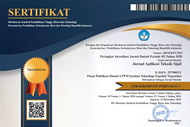Peningkatan Kinerja Biaya Berbasis Value Engineering Pada Proyek Green Hospital
Abstract
Dalam pekerjaan Rumah Sakit yang berkonsep Green, ada beberapa ketentuan yang harus dipatuhi bahwa semua proses baik material yang dipilh, metoda pelaksanaan maupun operasional bangunan harus mengacu pada kaidah Green. Dengan menggunakan metoda Value Engineering (VE) kemudian Life Cycle Cost Analysis (LCCA), peneliti mencoba menerapkan konsep Green Hospital pada proyek yang menjadi studi kasus namun tetap berbiaya efisien bahkan lebih rendah dari Rencana Anggaran Biaya (RAB) yang awal. Untuk mengetahui pengaruh kedua metoda efesiensi biaya terhadap proyek green hospital, peneliti menyebarkan kuesioner kepada para stakeholder , hasil dari kuesioner tersebut dikumpulkan, diolah dan dianalisis menggunakan SPSS Ver. 21.0. Ternyata bahwa penggunaan metoda VE dan LCCA ini sangat berpengaruh dalam meningkatkan kinerja biaya. Dari kesimpulan yang ada metoda LCCA menunjukkan pembayaran kembali (Payback Period) untuk Pembangkit Listrik Tenaga Surya dengan waktu = 9,64 Tahun ≈ 9 Tahun 7 Bulan, Pemusnah Limbah B3 dengan waktu = 4,28 Tahun ≈ 4 Tahun 3 Bulan
Keywords
Full Text:
PDFReferences
F. J. Montiel-Santiago, M. J. Hermoso-Orzáez, and J. Terrados-Cepeda, “Sustainability and Energy Efficiency: BIM 6D. Study of the BIM Methodology Applied to Hospital Buildings. Value of Interior Lighting and Daylight in Energy Simulation,” Sustainability, vol. 12, no. 14, p. 5731, 2020.
Y. Han, T. He, R. Chang, and R. Xue, “Development Trend and Segmentation of the US Green Building Market: Corporate Perspective on Green Contractors and Design Firms,” J. Constr. Eng. Manag., vol. 146, no. 11, p. 05020014, 2020.
M. Spišáková, P. Mésároš, and T. Mandičák, “Construction Waste Audit in the Framework of Sustainable Waste Management in Construction Projects—Case Study,” Buildings, vol. 11, no. 2, p. 61, 2021.
K. J. Mejía, M. D. M. Barbero-Barrera, and M. R. Pérez, “Evaluation of the impact of the envelope system on thermal energy demand in hospital buildings,” Buildings, vol. 10, no. 12, pp. 1–17, 2020.
S. Atabay, A. Pelin Gurgun, and K. Koc, “Incorporating BIM and Green Building in Engineering Education: Assessment of a School Building for LEED Certification,” Pract. Period. Struct. Des. Constr., vol. 25, no. 4, p. 04020040, 2020.
N. Campion, C. L. Thiel, J. Focareta, and M. M. Bilec, “Understanding Green Building Design and Healthcare Outcomes: Evidence-Based Design Analysis of an Oncology Unit,” J. Archit. Eng., vol. 22, no. 3, p. 04016009, 2016.
B.-G. Hwang, L. Zhu, Y. Wang, and X. Cheong, “Green Building Construction Projects in Singapore,” Proj. Manag. J., vol. 48, no. 4, pp. 67–79, 2017.
V. Basten, I. Crévits, Y. Latief, and M. A. Berawi, “Conceptual development of cost benefit analysis based on regional, knowledge, and economic aspects of green building,” Int. J. Technol., vol. 10, no. 1, pp. 81–93, 2019.
R. Doczy and Y. AbdelRazig, “Green Buildings Case Study Analysis Using AHP and MAUT in Sustainability and Costs,” J. Archit. Eng., vol. 23, no. 3, p. 05017002, 2017.
P. Miraj, M. A. Berawi, G. Gunawan, and A. E. Husin, “Conceptual Design of Sunda Strait Bridge Using Value Engineering Approach Conceptual Design of Sunda Strait Bridge Using Value Engineering Approach,” no. December, 2012.
T. C. Marrana, J. D. Silvestre, J. De Brito, and R. Gomes, “Lifecycle Cost Analysis of Flat Roofs of Buildings,” J. Constr. Eng. Manag., vol. 143, no. 6, 2017.
A. E. Husin, M. A. Berawi, S. Dikun, T. Ilyas, and A. R. B. Berawi, “Forecasting demand on mega infrastructure projects: Increasing financial feasibility,” Int. J. Technol., vol. 6, no. 1, pp. 73–83, 2015.
A. Naidenov and A. Naidenov, “Using SPSS for Process Quality Control – A Critical Review Using SPSS for Process Quality Control – A Critical Review,” no. FEBRUARY 2014, 2015.
S. Moradi, K. Kähkönen, and K. Aaltonen, “Project managers’ competencies in collaborative construction projects,” Buildings, vol. 10, no. 3, pp. 1–17, 2020.
H. Liu, “Evaluating Construction Cost of Green Building Based on Life- cycle Cost Analysis : An empirical analysis from Nanjing , China,” vol. 9, no. 12, pp. 299–306, 2015.
H. T. T. Le, V. Likhitruangsilp, and N. Yabuki, “A BIM-integrated relational database management system for evaluating building life-cycle costs,” Eng. J., vol. 24, no. 2, pp. 75–86, 2020.
H. Huang, Y. Huang, and Y. Perng, “Evaluating critical criteria for green hospital buildings Evaluating critical criteria for green hospital buildings,” 2020.
A. Hatami and G. Morcous, “Deterministic and Probabilistic Lifecycle Cost Assessment: Applications to Nebraska Bridges,” J. Perform. Constr. Facil., vol. 30, no. 2, 2016.
P. Samani, J. Gregory, V. Leal, A. Mendes, and N. Correia, “Lifecycle Cost Analysis of Prefabricated Composite and Masonry Buildings: Comparative Study,” J. Archit. Eng., vol. 24, no. 1, pp. 1–11, 2018.
K. Khun-Anod and C. Limsawasd, “Pre-project planning process study of green building construction projects in Thailand,” Eng. J., vol. 23, no. 6, pp. 67–81, 2019.
M. A. Berawi et al., “Developing conceptual design of high speed railways using value engineering method: Creating optimum project benefits,” Int. J. Technol., vol. 6, no. 4, pp. 670–679, 2015.
A. Darvish, S. R. Eghbali, G. Eghbali, and Y. G. Mahlabani, “The Effects of Building Glass Façade Geometry on Wind Infiltration and Heating and Cooling Energy Consumption,” vol. 11, no. November 2019, pp. 235–247, 2020.
J. Lee, “Value Engineering for Defect Prevention on Building Façade,” vol. 144, no. Beasley 2014, pp. 1–8, 2018.
B. A. Rock, “Comparing building surfaces’ orientations to optimize solar energy collection,” J. Green Build., vol. 15, no. 2, pp. 3–28, 2020.
C. Basu, V. K. Pau, and M. G. M. Syal, “Performance indicators for energy efficiency retrofitting in multifamily residential buildings,” J. Green Build., vol. 14, no. 2, pp. 109–136, 2019.
D. Satola, M. Röck, A. Houlihan-Wiberg, and A. Gustavsen, “Life cycle GHG emissions of residential buildings in humid subtropical and tropical climates: Systematic review and analysis,” Buildings, vol. 11, no. 1, pp. 1–36, 2021.
J. Park, D. Hengevoss, and S. Wittkopf, “Industrial data-based life cycle assessment of architecturally integrated glass-glass photovoltaics,” Buildings, vol. 9, no. 1, pp. 1–19, 2018.
P. Filipek, “Investigation of the E ff ective Use of Photovoltaic,” 2020.
K. Joseph, A. Selvam, and J. W. C. Wong, “Healthcare waste management,” Sustain. Solid Waste Manag., pp. 477–510, 2016.
P. R. Rout, P. Bhunia, A. Ramakrishnan, R. Y. Surampalli, T. C. Zhang, and R. D. Tyagi, “Sustainable hazardous waste management/treatment: Framework and adjustments to meet grand challenges,” Sustain. Solid Waste Manag., pp. 319–364, 2016.
DOI: http://dx.doi.org/10.12962%2Fj2579-891X.v19i3.9144
Refbacks
- There are currently no refbacks.

Jurnal Aplikasi Teknik Sipil by Pusat Publikasi Ilmiah LPPM Institut Teknologi Sepuluh Nopember is licensed under a Creative Commons Attribution-ShareAlike 4.0 International License
Based on work at https://iptek.its.ac.id/index.php/jats




